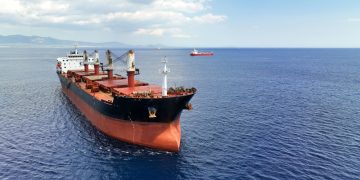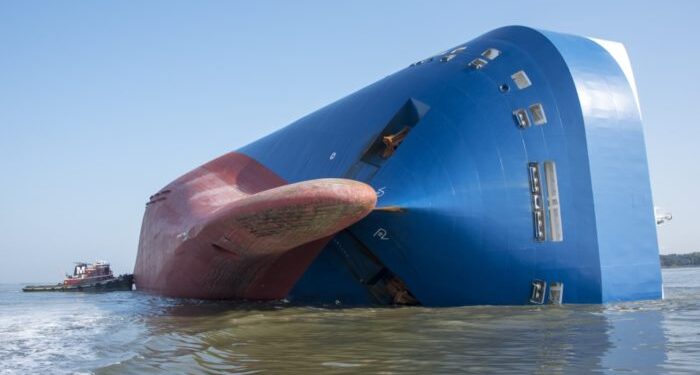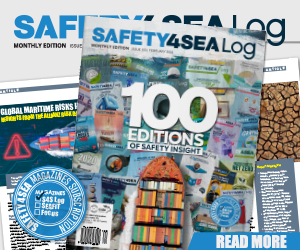MV Golden Ray capsized while departing the port of Brunswick, Georgia early in the hours of September 8, 2019. After two years, the National Transportation Safety Board (NTSB) released its investigation report mentioning as probable cause of the capsizing the chief officer’s error entering ballast quantities into the stability calculation program, which led to his incorrect determination of the vessel’s stability. Following the release of the report, Dr. Sal Mercogliano, stresses that there were many issues at play and while the NTSB looked at the who, what, where, and how, they failed to address the biggest question WHY?
In a video, Dr. Sal Mercogliano, Chair of the Department of History, Criminal Justice and Political Science, former merchant mariner, and adjunct professor of Maritime Industry Policy at the US Merchant Marine Academy, examines NTSB report on the capsizing of the roll-on/roll-off vehicle carrier MV Golden Ray, breaks down the events of the day, looks at the evidence presented to the NTSB, their analysis and questions their final determination that laid the fault squarely on the shoulders of the ship’s Chief Mate.
As in most NTSB reports, the who, what, where, and how are extensively investigated and detailed. What is glaringly missing, however, is WHY?
…Dr. Mercogliano said.
Furthermore, in a recent publication by IIMS, Dr. Mercogliano writes the NTSB ruled out weather, the transfer of ballast or fuel during the transit, malfunction of the propulsion and steering systems, the shifting of cargo, obstructions in the channel, or a fire in the hold. With none of those present, the bureau focused on the actions – or more appropriately, inactions – of the First Mate, who also served as the cargo officer, in failing to properly input the readings from the ship’s 21 ballast tanks into the shipboard stability computer (LOADCOM). This error resulted in the incorrect determination of the vessel’s stability. With that error, and the ship lacking the adequate metacentric height (GM) to properly right the vessel in the final turn toward the open sea as the vessel sped up, it resulted in the centers of gravity and buoyancy rolling the vessel when she heeled past 8 degrees.
With regards to the accident, Dr. Mercogliano questions the following WHYs in the article published in ‘IIMS 2021 Safety & Loss Prevention Briefings Compendium’ that the NTSB report doesn’t give answers to:
- Why did the Chief Mate, who had been serving on the ship for over six months, with six years in car carriers and ten years as First Officer, fail to input the correct data from the ballast tanks into the LOADCOM?
- Why, after he ordered the quartermaster to sound the tanks to ensure that the computer soundings matched the actual readings, did he input the incorrect data?
- Why did he fail to use the automated feature on the system that automatically linked this data directly to the LOADCOM computer?
- Finally, why did the NTSB not ask these questions?
”Not once discussed in report is the ship’s ballast water treatment plant. It is represented in a graphic on page 46 that details the ship’s water ballast system.” mentions Dr. Mercogliano explaining that when Golden Ray sailed into Jacksonville, Florida, the port before Brunswick, it had offloaded 1,500 MT of ballast to raise the vessel to make the required draft of 31 feet. After sailing, it did not take on any more ballast. When it arrived at Brunswick, it also failed to take on ballast as it navigated the 36-foot channel, with a maximum permissible draft of 33 feet. In Brunswick, the ship offloaded and loaded vehicles and increased its cargo weight by 373 MT, but failed to take on ballast; why?
”The answer lies in the fact that when a ship loads ballast, the water runs through the ballast water treatment plant. It takes time to remove sediment, silt, and biological organisms from the water before it could be loaded in the tanks. There is less of this material in the open blue water of the Atlantic compared to the brown water of St. Simon’s. Additionally, the material gathered in the ballast water treatment plant cannot be discharged in US waters but pumped ashore for further treatment, according to the US Coast Guard. So, why would an experienced Chief Mate input false reading into the LOADCOM when he knew that the computer soundings had been verified?” he continued in his article.
As the LOADCOM data was destroyed in the accident, we cannot know for sure, but it appears that the Chief Mate intended for the ship to show an acceptable GM, not thinking that the ship would suffer a catastrophic heeling motion. He probably intended to load ballast water once clear of the coast and in blue water. We do not know if the Chief Mate intended to ballast once clear of Brunswick, or even wait until final cargo operations were completed in Baltimore.
The failure of the NTSB to address this issue means that car carriers entering and leaving Brunswick, Georgia currently, and for the past two years, and every other port in the United States, may have officers on board the ship inputting false data to avoid fouling their ballast water treatment plant. Failure to have the LOADCOM computer directly linked to the ballast tank sensors, verified with soundings, and then uplinked to the company’s engineering firm to determine the stability of the vessel, and waiting for the verification of the load and stability data were not addressed in this report. Yet, these factors contributed to the accident.
By focusing solely on the Chief Mate, and to a lesser extent on G-Marine Services failing to have an effective ship management system regarding ship’s stability, the potential for another car carrier capsizing in US waters has not been eliminated or even substantially diminished.
…Dr. Mercogliano concluded.


































































